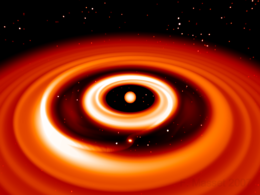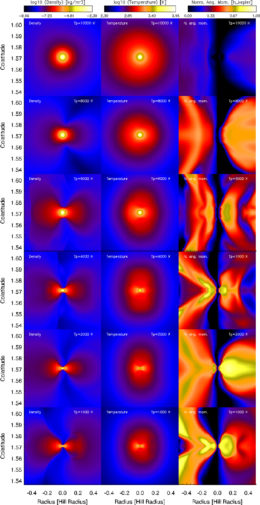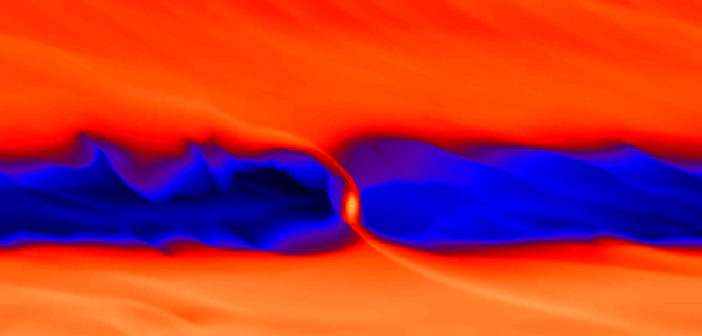Giant planets are thought to form in circumstellar disks surrounding young stars, but material may also accrete into a smaller disk around the planet. We’ve never detected one of these circumplanetary disks before — but thanks to new simulations, we now have a better idea of what to look for.

Image from previous work simulating a Jupiter-mass planet forming inside a circumstellar disk. The planet has its own circumplanetary disk of accreted material. [Frédéric Masset]
Elusive Disks
In the formation of giant planets, we think the final phase consists of accretion onto the planet from a disk that surrounds it. This circumplanetary disk is important to understand, since it both regulates the late gas accretion and forms the birthplace of future satellites of the planet.
We’ve yet to detect a circumplanetary disk thus far, because the resolution needed to spot one has been out of reach. Now, however, we’re entering an era where the disk and its kinematics may be observable with high-powered telescopes (like the Atacama Large Millimeter Array).
To prepare for such observations, we need models that predict the basic characteristics of these disks — like the mass, temperature, and kinematic properties. Now a researcher at the ETH Zürich Institute for Astronomy in Switzerland, Judit Szulágyi, has worked toward this goal.
Simulating Cooling
Szulágyi performs a series of 3D global radiative hydrodynamic simulations of 1, 3, 5, and 10 Jupiter-mass (MJ) giant planets and their surrounding circumplanetary disks, embedded within the larger circumstellar disk around the central star.

Density (left column), temperature (center), and normalized angular momentum (right) for a 1 MJ planet over temperatures cooling from 10,000 K (top) to 1,000 K (bottom). At high temperatures, a spherical circumplanetary envelope surrounds the planet, but as the planet cools, the envelope transitions around 6–4,000 K to a flattened disk. [Szulágyi 2017]
Predicted Characteristics
Szulágyi’s work produced a number of intriguing observations, including the following:
- For the 1 MJ planet, a spherical circumplanetary envelope forms at high temperatures, flattening into a disk as the planet cools. Higher-mass planets form disks even at high temperatures.
- The disk has a steep temperature profile from inside to outside, and the whole disk is too hot for water to remain frozen. This suggests that satellites couldn’t form in the disk earlier than 1 Myr after the planet birth. The outskirts of the disk cool first as the planet cools, indicating that satellites may eventually form in these outer parts and then migrate inward.
- The planets open gaps in the circumstellar disk as they orbit. As a planet radiates away its formation heat, the gap it opens becomes deeper and wider (though this is a small effect). For high-mass planets (>5 MJ), the gap eccentricity increases, which creates a hostile environment for satellite formation.
Szulágyi discusses a number of features of these disks that we can plan to search for in the future with our increasing telescope power — including signatures in direct imaging and observations of their kinematics. The results from these simulations will help us both to detect these circumplanetary disks and to understand our observations when we do. These future observations will then allow us to learn about late-stage giant-planet formation as well as the formation of their satellites.
Citation
J. Szulágyi 2017 ApJ 842 103. doi:10.3847/1538-4357/aa7515


3 Comments
Pingback: protoplanetary disks
Pingback: Why Jupiter spins fast, but not really fast | astrobites
Pingback: Why Jupiter Spins Fast, but Not Really Fast